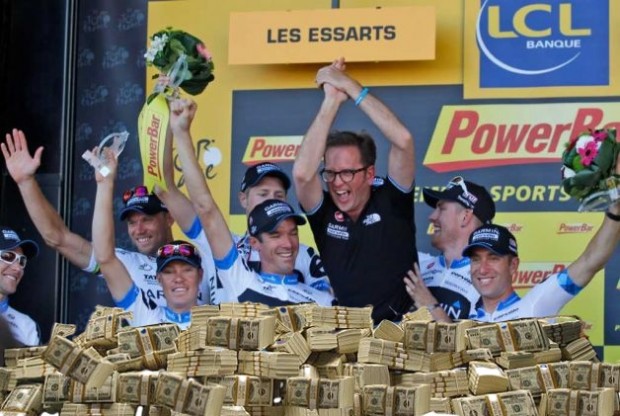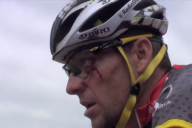In the penultimate part of our series looking at some of the key aspects of the revenue-sharing debate, we try to address some of the practicalities – and impracticalities – of sharing more revenue with the teams. And we look to the future and the role fans have in the debate.
The AIGCP are but one of many supplicants asking the Amaurys to share more of their wealth with them. Before coming back to the AIGCP’s case, let’s consider some of their revenue-sharing rivals.
Away back in the eighties, when the Tour was heading toward gigantisme and was finally contributing something to the Amaurys’ wealth, Félix Lévitan claimed that the race received not even a single centime in public subsidy. In this Lévitan was not wrong. So sure of himself was he that he even offered to throw open the Tour’s books to prove his point. But, at the same time, Lévitan was not right. For the Tour has always been subsidised by the French state.
After the end of the second world war, the French state began to pay subsidies to newspaper operators. At a time when the Tour was a financial drain on the coffers of L’Équipe and Le Parisien Libéré – remember, it was 1974 before it turned its first profit – Émilien Amaury’s newspapers were receiving subsidies from the state. Indirectly, those subsidies subsidised the Tour.
Another form of state subsidy is the cost of policing sporting events. Increasingly, this is a matter of concern to policing authorities throughout the developed economies. Organisers of sporting events pay a fraction of the true cost of policing their events. Were they to have to pay the true cost, many smaller sporting events would simply cease to exist. The Amaurys today are trying to find a balance between paying a fairer cost for the policing of their events and resisting calls to meet the full cost.
Elsewhere, there is the cost of road closures. A 2009 Le Monde Diplomatique story noted that the Tour pays the Assemblée des Départements de France just €270,000 for road closures, which works out at about €75 a kilometre. The ADDDF are not yet demanding that ASO pay more, but the more others point out how little they currently pay, the harder it is for ASO to get away with paying such a small amount for the use of France’s roads.
There was even a challenge against the Paris-Dakar Rally to the amounts paid by towns, cities and départements to host sporting events (fees which contribute to the Tour’s bottom line). Rules on local government finance, it was argued, forbid such payments. It is perfectly acceptable, it was argued, to subsidise businesses creating local employment. It is not legal, the argument went, to use such money for sporting events. The initial challenge against the Dakar was successful, but in the years since then ASO appear to have found the necessary loophole that enables them to continue to receive payments from host towns. Loopholes can always be closed.
Those are just some of the ways the French state subsidises the Tour, and some of the challenges being faced by ASO. The other side of the coin is the amount ASO pays to subsidise cycling at grassroots levels in France. The French cycling federation (FFC) claim that ASO pay something in the region of just €1.2 million to support cycling at grassroots levels. ASO make a counter argument that their races, at all levels, need to be taken into account, not just the amount they pay to the FFC. But mischievous sorts also like to point out that JC Decaux, who underwrite the cost of Paris’ Vélib’ bike-sharing scheme and similar schemes in other cities, pay more to encourage cycling in France than the Amaurys do.
The AIGCP, then, are but one in a long queue of supplicants standing at the door of ASO’s headquarters. And standing right being the AIGCP is the CPA, the riders’ representative body, who are always ready to call for more money if they see someone else getting a larger slice of the cake.
The Amaurys, though, are used to this sort of thing. Look at the media side of their empire and consider the manner in which they have dealt with the print and journalist unions. Unions, by their very nature, always want more for their members. Bosses, by their very nature, always want to resist such calls. The Amaurys have been in the newspaper business since 1944. That’s close to seventy years of experience dealing with people calling for a greater share of the cake. Remember the story of that two-and-a-half-year strike that hit Le Parisien Libéré in the mid-seventies? It was included in this series for a reason. It demonstrates that the Amaurys are no pushovers when it comes to calls upon them to share more and more of their wealth.
The AIGCP, then, will need to make a very good case if they expect ASO to pay the teams more than the €1.6 million currently shared with them at the Tour. Consider, for instance, the basic €51,243 that the teams have been receiving as a participation allowance. This was originally negotiated before the current AIGCP president, Jonathan Vaughters, took office. It has been renegotiated every year since. And every year it has remained unchanged. The whole €1.6 million has, more or less, hardly changed over the last four years. That should indicate to you the scale of the problem facing the AIGCP today. ASO do not give in easily.
How much do the AIGCP actually want? That’s not known. Jonathan Vaughters did recently put a figure of €10 million on it but, when questioned as to whether this was from the just the Tour, from all of ASO’s races or from all race organisers in total, he withdrew the number. My own feeling – and this is nothing more than a gut-feeling based on nothing more than instinct, and should therefore be taken with a very large pinch of salt – is that the AIGCP are probably looking for something in the region of €5 million to €10 million from ASO, and the same again from the other race organisers.
Let’s take the bottom value of that ballpark, a total of €10 million from all race organisers. What would the AIGCP do with such a sum of money? Back in the Summer, when the AIGCP were boycotting France Télévisions in their attempts to press their case, it seemed that the money would simply pass back to the teams and be spent by them as they wished. Some of the money, we were told, would go toward anti-doping. But the rest the teams would be free to spend as they saw fit.
The biggest cost faced by cycling teams today is riders’ wages. At times, it is hard not to think of some of the teams as being like children rushing to spend all their pocket-money on the latest, shiniest toy in the shop window. Look at teams like Leopard, BMC, and Sky and the amounts they are spending on riders. Were the teams to get an extra €10 million between them, what’s to stop them just blowing it all on increased salaries for top riders as they outbid themselves for the fastest sprinter, the lightest climber and the best time trialist money can buy? What’s to stop all that money simply leaving the sport through the riders’ bank accounts?
Here the AIGCP offered the security of a salary cap. There’s various different forms of salary caps, but the most efficient – or the least inefficient – is the one which puts an upper maximum on a team’s total salary outlay. Given that teams are of a fixed size – 25 to 30 riders – this is relatively easy to implement, should all the teams agree to it. Sadly, it is almost impossible to police. In virtually every sport in which salary caps are in place, the same things happen: the teams either blatantly ignore them or abuse every loophole in the book to get around them.
Let’s consider the simplest way of getting around a salary cap: get someone else to pay your rider’s salary. A simple example for you – consider Mark Cavendish and his deal with Specialized. That is a personal deal, between the rider and the bike manufacturer. That his HTC team also have a deal with Specialized is neither here nor there. The money paid to Cavendish by Specialized is paid direct, without going through HTC’s budget. Thus it would not have been covered by a salary cap.
Any team then, wishing to get around a salary cap, would simply have to keep some sponsorship income off their books by getting the sponsor to do a deal directly with a rider. And that is just one loophole. I won’t bother going into the dozens of others that are used in sports that have salary caps in place. The point is, I think, made: salary caps are just window dressing.
This week, though, the issue of the salary cap was taken off the table when the AIGCP president suggested that the extra money being demanded by teams would effectively go to a central fund. Anti-doping would receive 20% of the fund. Another 60% of it would be set aside, similar to the ProTour reserve, and be able to be called upon by teams in financial difficulties. The balance would be disbursed among the teams, for them to spend as they see fit.
In theory, this is good. The practicalities of the matter, though, are far from simple. Now, just because something is difficult doesn’t mean that it shouldn’t be done. But the practicalities do need to be considered. Consider, for instance, the manner in which race organisers might make an extra €10 million available to teams. Some of it would, in all likelihood, be paid in the form of increased participation allowances (remember, the current UCI figure is just €7,500 and covers just the ProTour teams and the WorldTour races, excluding the Grand Tours). Some of the increased payout to teams would, in all likelihood, be linked to performance, paid in the form of prizes or bonuses.
Consider, for instance, the Tour. Let’s assume that ASO can be convinced to grant an extra €5 million from the Tour’s bottom line to the teams. If you were in ASO, at most you would grant only half of that in increased participation allowances. Which would bring the allowance up from the current €51,243 to €165,000 (I am here just tossing numbers about – bearing in mind that the current €51,243 is unchanged over at least four years, the likelihood of it jumping up to €165,000 in the short-term seems outlandish).
The other half – €2.5 million – were you ASO, you might want to link to performance. You would make it available to the teams through enhanced team prizes, linked to their performance in the Tour. Which means that some teams would pocket more than others. Recall, for instance, that breakdown of the 2011 Tour prize fund we looked at earlier in this series. Of the performance-related element of the €1.6 million currently shared with the teams (€433,000) Garmin-Cervélo pocketed €81,200 while Vacansoleil and Katusha pocketed just €200. That’s not a typo. That’s really two hundred euros. Radioshack pocketed just €700. The average was €19,682. The median was just €14,625.
The difficulty then is in making a performance-related element of any increased payout to the teams available to the sort of reserve fund suggested by the AIGCP. Difficult, yes. But not impossible. And so not a reason not to do it. But, as I say, such difficulties do need to be considered. If the AIGCP cannot convince you or me of the practicalities of their plan, what hope do they have against someone as well-versed in negotiating as ASO? You and me, we’re pussycats when compared to ASO.
* * * * *
Why am I making these observations? Because I do believe that fans have a role to play in this. Consider doping. Why didn’t cycling clean up its act post-Festina? Because, as Benjo Maso has noted, the fans didn’t want to know about it, the riders didn’t want to talk about and the media didn’t want to report it. Why did the sport finally begin to change itself after Operación Puerto? Because the balance of power had shifted.
What changed? Among other things, the power of the fans changed. Ten years ago, fifteen years ago, we didn’t matter. We had no voice. Then the internet came along and gave us a voice. An imperfect voice, I’ll accept. And a voice which doesn’t always reflect positively on us. But a voice nonetheless. And journalists who once didn’t want to report the reality of this sport began to see there is an audience for reality. And the editors who once didn’t want their journalists reporting reality began to see there is an audience for reality. It became harder to ignore us, the fans, the people who buy the products sold by the sponsors who fund the teams who employ the riders who keep the wheels of this sport going around. The dumb schmucks in the cheap seats. The least important stakeholder in cycling.
I’m not here trying to blow the trumpet for the Internet or for sites like this. There’s an awful lot about the Internet that I hate, and even on a site like this there are things I don’t agree with. I’m merely trying to acknowledge fairly what changed. The Internet changed the way this sport is reported. And that has helped to change what is happening in this sport. If you don’t believe that, then ask yourself this: why did Paul Köchli fail in his attempts to operate a Team Clean in the nineties, when men like Jonathan Vaughters were able to succeed in the noughties?
Fans have a role to play in how cycling moves forward over the next few years. We can influence those team managers who, like Jonathan Vaughters, take the time out to listen to us. We can influence those journalists who report this sport properly and their editors who limit what they can and cannot report on. Ultimately, through those indirect channels, we can influence the race organisers. And through them we can influence the UCI.
We have a voice in the revenue-sharing debate. The AIGCP have, so far, been the ones framing the debate. Using the media to make the issue public. We don’t have to be passive, to simply sit back and listen to what they choose to tell us. We have today, through the Internet, a chance to join in the debate. To influence its outcome. I have tried in this series to offer my take on what I see as being some of the key aspects of the revenue-sharing debate. The issues I think need to be considered when looking at revenue sharing. To move the debate forward, the rest is up to you. You have a voice. Use it.
Next: Paris – the end of the road (for now).
Previously: Calculating the Tour’s TV Revenues.
















No Comments